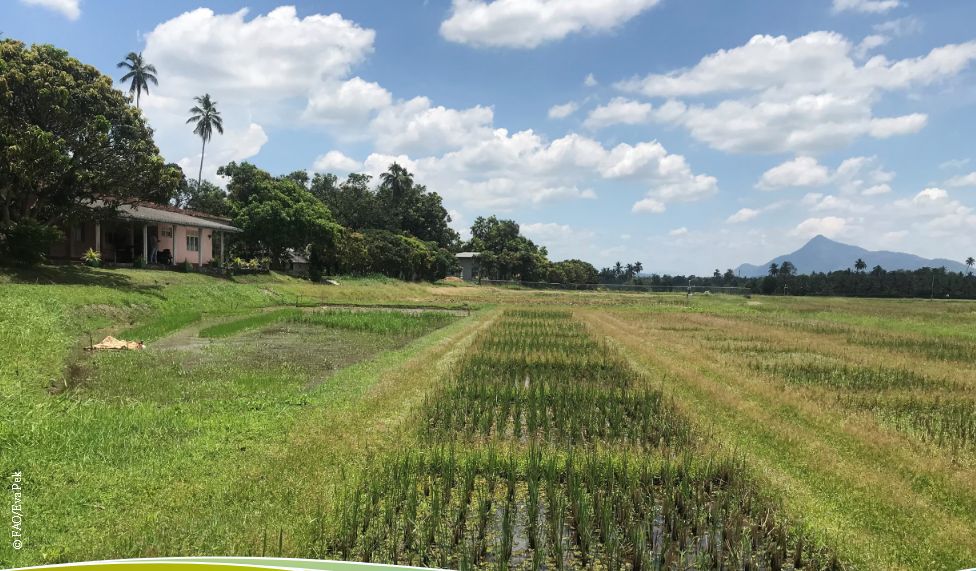
Why Sri Lanka’s smallholder rice farmers hold the key to sustainable water management
by Imre Fertő
Water is both the lifeblood and the Achilles’ heel of Sri Lanka’s rice economy. For generations, the island’s ancient irrigation systems have sustained paddy cultivation—the foundation of food security and rural livelihoods. Yet, as climate variability intensifies, these same systems face mounting strain. A new FAO study, led by researchers from the HUN-REN Centre for Economic and Regional Studies and the Food and Agriculture Organization, argues that sustainable transformation of Sri Lanka’s rice sector depends not only on technology, but on understanding how smallholders perceive risk, manage resources, and make decisions.
A system under pressure
Rice farming supports one-third of Sri Lanka’s rural population. While the country has achieved near self-sufficiency in rice, this success masks deep regional disparities and growing water inefficiencies. Droughts, floods, and irregular monsoon patterns are now common, threatening productivity and livelihoods. Despite heavy investment in irrigation infrastructure, the report warns that “water abundance can no longer be taken for granted.”
Drawing on surveys of 301 smallholder farmers across three provinces—Western (WP), North Western (NWP) and North Central (NCP)—the research finds stark differences in production systems, climate exposure, and adaptation capacity. In the dry NCP, farmers battle recurring droughts, relying on centuries-old reservoirs to sustain yields averaging 6,270 kg of rice per year. In contrast, the wet-zone WP faces chronic flooding and declining productivity, with average annual output barely half that figure. The NWP sits in between, coping with both drought and flood hazards.
This ecological diversity, the report concludes, requires regionally tailored policies rather than uniform interventions. “From prolonged drought to sudden floods, the regional differences underscore the need for targeted, context-specific strategies,” the authors note.
Perception gaps: when risk is invisible
One of the study’s most striking findings is that farmers consistently underestimate the severity of climate risks. Using a combination of socioeconomic surveys, cluster and factor analysis, and meteorological data from 1991–2024, the team found a disconnect between recorded drought intensity and farmers’ own recollections. Many farmers reported only one drought in the past decade—when rainfall data indicated at least three or four severe dry spells.
This perception gap matters. When risks are invisible, adaptation stalls. Farmers who perceive floods or droughts as rare are less likely to invest in preventive measures such as drainage, water-saving irrigation, or improved seed varieties. “Bridging gaps between perceived and actual risks is essential,” the report argues, calling for stronger early-warning systems, localized data access, and participatory extension services.
Digital tools could help. Nearly all farmers own mobile phones, but most rely on traditional media and interpersonal channels for weather updates. Integrating digital alerts into these networks could shorten communication chains and increase preparedness.
What makes farmers adapt—or resist change
Beyond awareness, adaptation depends on resources, incentives, and institutional support. The FAO’s discrete choice experiment—a behavioral method that presents farmers with hypothetical management options—revealed a cautious but pragmatic attitude toward innovation. Smallholders are open to new techniques, but only if they align with local conditions and do not add complexity or cost.
Farmers showed the strongest preference for “moderately progressive, technology-independent” practices—such as better soil management, optimized fertilizer use, and improved seed selection—over high-tech systems like sensor-based irrigation. As the report notes, “gradual and incremental introduction of technologies is essential.”
Access to credit, land tenure security, and irrigation infrastructure all play decisive roles. Factor analysis highlighted three key dimensions shaping farmers’ decisions:
1. Production costs and input access – including machinery, fertilizer, and labour.
2. Land and irrigation ownership – influencing willingness to invest.
3. Market orientation – determining whether production is for household consumption or sale.
Where land tenure is insecure or irrigation unreliable, investment in new practices is rare. Conversely, farmers with better access to water and markets are more likely to adopt innovative and multifunctional practices.
Piloting the future: what works on the ground
The report’s pilot phase tested a suite of combined farm and water management practices—ranging from soil fertility improvement and alternate wetting–drying irrigation to leaf colour-based fertilization. Results were striking: yields and crop water productivity increased significantly, while irrigation use fell. Profit gains reached up to 400 percent in some regions during the Yala season.
These findings demonstrate the potential of integrated approaches—yet also the importance of adaptability. Not every technology suits every farm. For instance, parachute seeding or precision irrigation can improve efficiency but demand higher labour or upfront investment, limiting uptake among the poorest households.
The authors stress that policies must couple infrastructure with capacity building. Demonstration plots, peer-learning, and field schools could help translate pilot successes into widespread adoption.
Reframing rice paddies as multifunctional landscapes
Perhaps the report’s most forward-looking insight is its call to recognize rice paddies as multifunctional ecosystems rather than mere production sites. Beyond providing food, they regulate water cycles, support biodiversity, and sustain rural employment. Yet most farmers remain unaware of these broader benefits.
When surveyed, farmers associated “multifunctionality” primarily with economic returns rather than environmental services. Awareness campaigns and incentive schemes could therefore help reposition multifunctionality as a shared public good—encouraging farmers to maintain landscapes that serve both local livelihoods and ecological resilience.
This framing aligns with global shifts toward nature-based solutions in agriculture, where paddy fields are viewed as potential carbon sinks, flood buffers, and biodiversity reservoirs. Recognizing and rewarding these roles could attract new investment and strengthen the social legitimacy of smallholder farming.
Policy implications: from pilots to pathways
The FAO team concludes that Sri Lanka’s water management transformation must proceed along regionally differentiated, farmer-centered pathways. Key recommendations include:
· Targeted investments in irrigation and drainage adapted to each province’s climate risks.
· Bridging perception gaps through localized weather services and climate education.
· Integrating multifunctionality into agricultural and environmental policy frameworks.
· Facilitating access to finance and secure land tenure to enable investment in innovation.
· Scaling proven pilot practices via participatory extension and demonstration programs.
The message is clear: resilience in Sri Lanka’s rice sector cannot be engineered through infrastructure alone. It must be cultivated through informed, empowered farmers who understand and manage risk within their local realities.
As climate pressures mount, these insights are not just relevant for Sri Lanka. They illustrate a global truth: sustainable water management begins not in government plans or engineering models, but in the decisions of smallholders whose fields feed the nation.
Fertő, I., Bakucs, Z., Pek, E., Salman, M., Herath, A., Kumari Rathnayake, W.M.U., & Sirisena, D.N. (2025).
Evidence-based analysis for integrating improved and multifunctional paddy water management into policy frameworks in Sri Lanka.
Rome, FAO, 2025.


